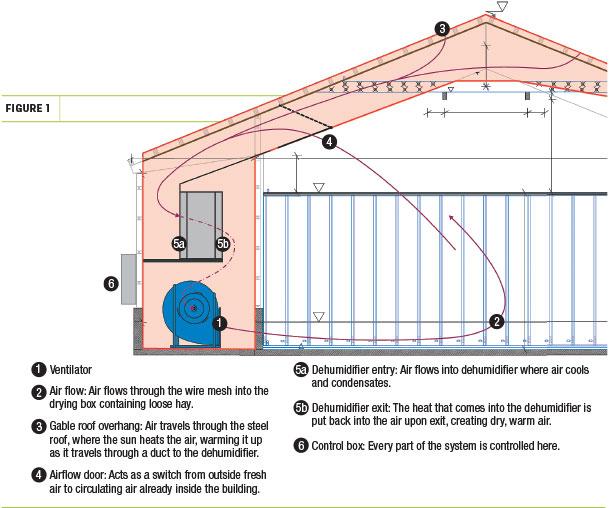With a desire to feed top-quality nutritious hay and increase their return on investment, Lars and Ingrid Steunebrink from Kirkton, Ontario, found themselves a new way to dry hay.
The couple decided to look outside the box for a profitable solution to feed their 600 dairy goats (Saanen, Alpine and Nubian) the best hay possible to keep them healthy and productive. They farm 225 acres of perennial rye, tall fescue and a festulolium blend, along with corn, beans and wheat.
Moving to Canada over 20 years ago from Holland, Lars and his family ran a pig farm, which they eventually sold because of the fluctuating hog prices. Lars met Ingrid in 2003, and after selling the family farm in 2014, they decided to make the switch to dairy goats.
Starting from scratch, they found open land just outside of St. Mary’s, built a new barn with a rotary parlor and started milking in 2016. In 2017, they installed a hay-drying system, and in the summer of 2018, they finished the drive shed that will be used for hay and equipment storage.
Challenges no more
“Weather is the biggest challenge. You need too many dry days in a row for field drying, but now we can make hay from the first cut to the last cut. A lot of other people have to wait with the first cut until June before they cut,” Lars says. “Still, to make dry hay is tough. Because it is humid and especially with the kind of grass that we have – lots of sugars – it is really hard to make dry hay in the field.
Even if you would leave the hay in the field for a week to get dry enough, then the quality goes down and there is no green color left, and the goats don’t like it as much anymore.” Nonetheless, the Steunebrink family is happy with their decision as they don’t have to worry about outside drying anymore. This summer, due to the lack of moisture, they collected four cuts of hay when normally they would collect five, cutting every 30 days starting mid- to late May.
Latest technology
After their multi-country tour to learn about the different hay-drying systems available, Lars decided to purchase the Austrian HSR Heutrocknug hay-drying system. The system includes an SR150 dehumidifier (Photo 1) and an SR1400 fan (Photo 2) with 80 kilowatts for two hay boxes (325 and 280 square meters, or 3,498 and 3,014 square feet).
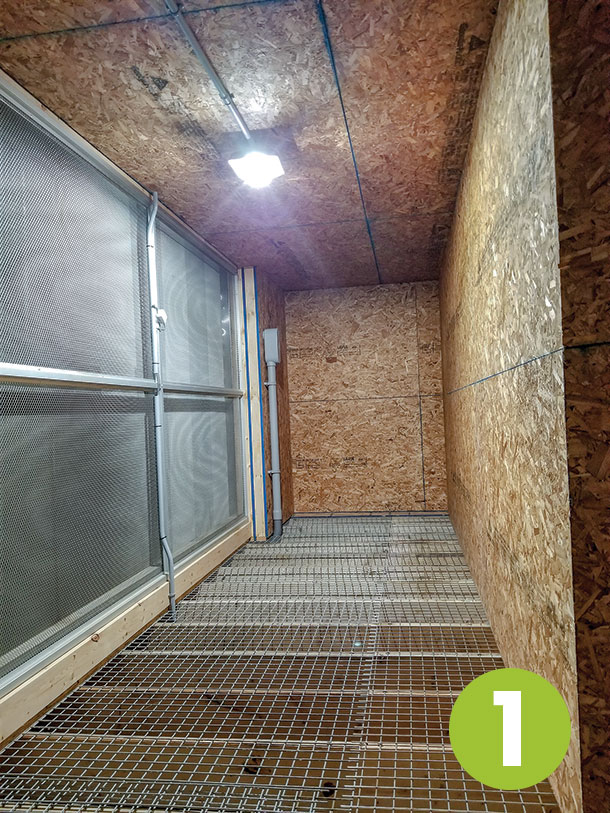
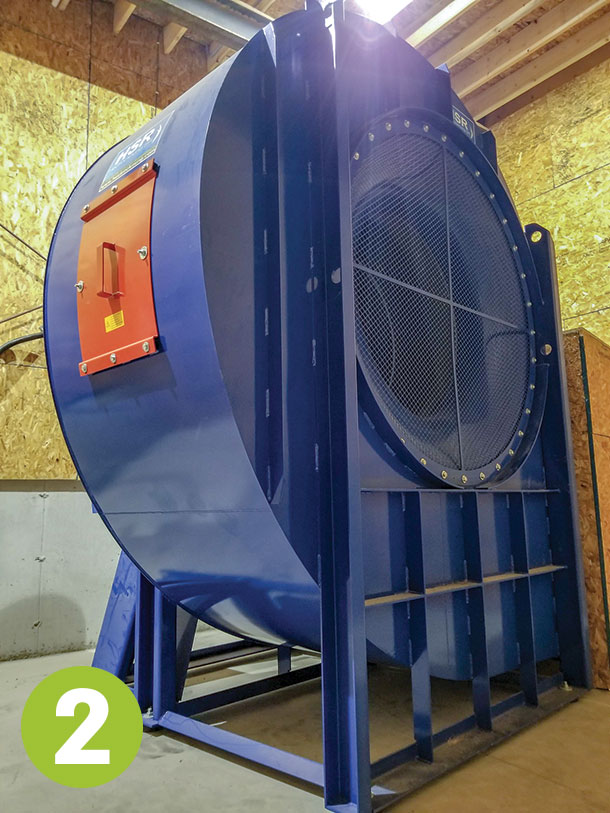
The system includes a hay crane (Photo 3) for collecting hay from the point of entry to distribute among the boxes.
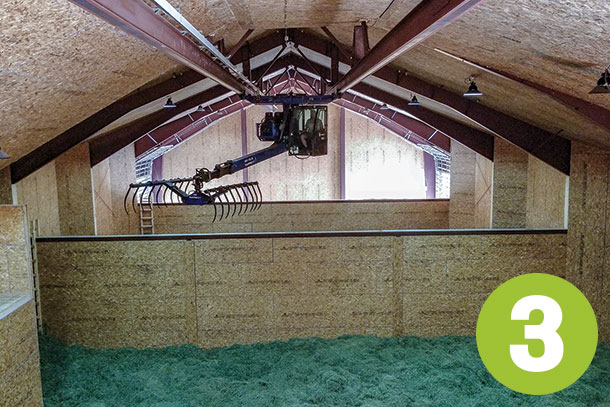
Lars and Ingrid had to purchase a self-loading wagon for hay collection and transportation from the field to the hay-drying boxes. The farm also has its own generator (300 kilovolt-amps) in case the power fails.
How it works
Looking at the schematic (see Figure 1), either the air comes in from above the hay or from outside, flowing just underneath the roof panels.
Click here or on the image above to view it at full size in a new window.
The air underneath the roof panels gets heated from the sun, which then goes through the dehumidifier that takes the moisture out. As a result, the air temperature will rise; then the air goes into the fan (because the fan sucks the air through the dehumidifier) that blows the air in the duct running underneath the hay.
The hay sits on 2-foot posts with a wire mesh on top, where hay will weigh approximately 110 kilograms per cubic meter (about 6.5 pounds per cubic feet).
The controller box (Photo 4) controls the dehumidifier and fan by measuring the hay temperature, inside air temperature, outside temperature, airspeed and the humidity above and underneath the hay-drying boxes.
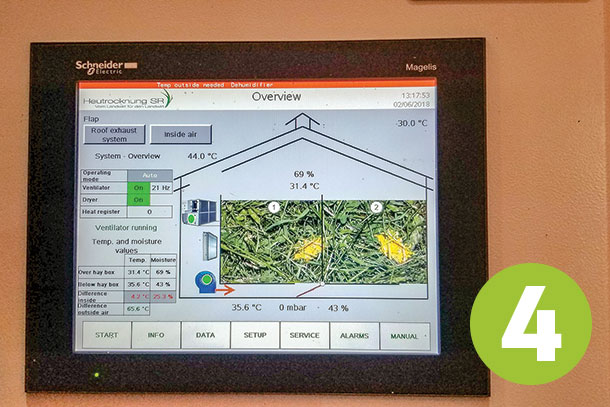
The intelligent technology decides if the air needs to flow in a closed loop or if the dehumidifier only takes outside air.
The physical part of the job involves someone to rake the hay in the field, someone to load it with the pickup wagon and someone to run the crane. As the Steunebrinks are only a team of two, it takes Lars and Ingrid two to four days to dry hay to the quality they are looking for using with the new system.
In one day, they can harvest 80 to 100 acres of hay, depending on road travel. The hay is collected in the pickup wagon using a maximum of seven knives. “Chopped grass would pack too much so the air couldn’t go through the system; however, when baling out of the box into big squares, you could run the knives in the baler.
“Grass gets picked up in the field at 30 to 35 percent moisture. The hay can be stored in the building, and wet hay can be dried on top of the dry hay. The maximum fill height for drying is about 6 meters high [about 19 feet], but could be filled up to 10 meters [about 32 feet] depending on moisture. The wetter the grass, the lower the height,” Lars says.
The cost is 0.5 to 1 cent per pound of dry hay. In case the Steunebrinks need more room for drying wet hay, they will bale hay into small squares (which they’ve done already) or look at making big square bales. For making the big squares, they would have to buy a bale feeder or modify a unit, which would also be usable in the field.
They plan on selling overproduction to local farmers. Lars says, “This year we’ll have extra, and that’s what we will try to sell in either bundles of small squares or big squares. Also, we have to try to get hooked up with the right people in the wholesale market.”
What’s next?
When asked what advice they would give to their younger selves before beginning this adventure, Lars says, “Get quicker on it. Do it earlier. Just don’t wait, do it. Waiting costs too much time.” Ingrid adds, “He also said that we should have moved to Canada 20 years earlier!”
To date, the Steunebrinks are happy with their decision. Since it has only been one season with the new system (the first batch of hay dried was the fifth cut in October 2017), it is still too new to have comparable statistics.
They selected this system over a traditional hay-drying method in the field, because “you have a larger capacity and better quality with a more stable outcome,” says Lars. Ingrid adds, “Because of the shorter field time, the grass is greener, tastes better and smells better.
We don’t have mold, and it’s just nice to feed goats with it. Their intake is better, and you can feed less pellets and grains. Since the nutrients in the grass and the hay are higher, we’re able to cut back on grains, which saves on costs.”
The quest for success has just begun for the Steunebrinks. One box of the new system will feed their goats for half a year at today’s herd size. Because the barn is very dry, they expect the hay-drying system to last over 20 years. Within the next 10 years, the couple plans to grow their operation, but for now, they are happy with the progress of their new dairy goat and hay business. ![]()
PHOTOS: Courtesy photos.
Steunebrinks would be happy to answer questions. Email Lars Steunebrink.

-
Lora Bender
- Editor
- Progressive Dairyman
- Email Lora Bender

